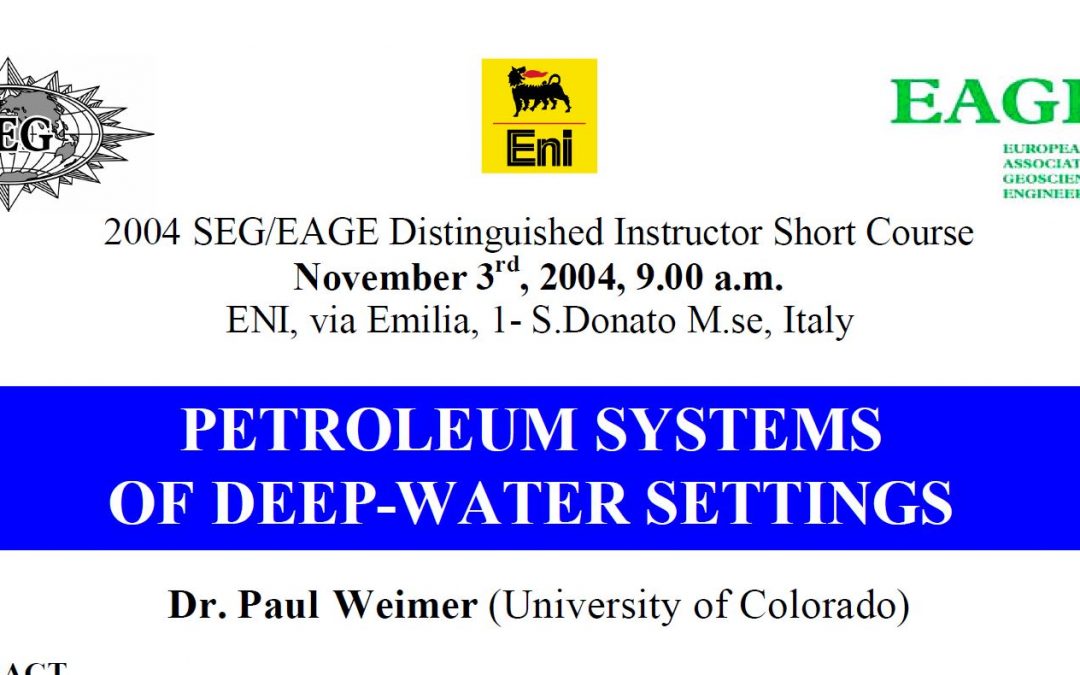Dr. Paul Weimer (University of Colorado)
PETROLEUM SYSTEMS OF DEEP WATER SETTINGS
2004 SEG/EAGE Distinguished Instructor Short Course
November 3rd, 2004, 9.00 a.m.
ENI, via Emilia, 1- S.Donato M.se, Italy
ABSTRACT
This course provides geophysicists with a broad overview of the petroleum systems of deep-water settings. The course design allows geophysicists to quickly integrate the information into their daily workflow. The material presented is approximately the 80-85th percentile of available information. Lectures will be complemented by extensive references to key publications that geophysicists may use to follow up. This course emphasizes the geologic aspects of deep-water deposits.
The course will start with an overview of the geology of deep-water systems, past, present and future. This review will cover the recent trends in deep-water in terms of drilling results, and introduce the elements of petroleum systems – reservoirs, traps, seals, source rock, migration, and timing. The key characteristics of the key reservoir elements in turbidite systems are: a) sheet sands (layered and amalgamated), b)channel fill, c) thin beds (overbank), and (d) slides and debris flows. The seismic stratigraphic expression of these systems is present in 2D, shallow 3D, and depth 3D, and integrated with the wireline log expression and information from outcrops, cores, and biostratigraphy. Examples from several producing basins around the world illustrate these points. The production history and the reservoir challenges in developing each of these fields is discussed. Participants are introduced to the basic occurrences of turbidite systems in a sequence stratigraphic framework. Examples show how to modify the basic model for each kind of basin setting (structural setting, faults, and salt), high frequency sequences, sediment delivery systems, and the effects of grain sizes on turbidite systems. Carbonate and lacustrine systems are also discussed. Many different kinds of basins produce from turbidite systems. A review of these basins shows the different tectonic settings and associated structural styles. The review also demonstrates that most reservoirs are pure stratigraphic traps or combined traps. A review of seals, source rocks and modeling principles gives the geophysicist practical techniques for understanding deep-water systems.
The course concludes with a summary of what is important in the exploration for and development of deep-water systems. The application of these techniques to each geophysicist’s current projects is key, as is the difference between frontier exploration and exploration in mature basins with deeper potential. Examples from 3 or 4 basins distributed globally illustrate the principles. These examples will also demonstrate that there is deep-water potential in most basins globally.
BIOGRAPHY
Paul Weimer has been a professor at the University of Colorado at Boulder since 1990. He holds the Bruce D. Benson Endowed Chair in Geological Sciences, and serves as Director of the Energy and Minerals Applied Research Center. His research has focused primarily on the petroleum systems of deep-water continental margins. Dr. Weimer has published more than 100 papers on a variety of topics: sequence stratigraphy, biostratigraphy, reservoir geology, petroleum systems, 3-D seismic interpretation, structural geology and tectonics. In 1998, a special edition of the AAPG Bulletin was dedicated to the research done at the University of Colorado by Dr. Weimer and colleagues on the petroleum geology of the northern deep Gulf of Mexico. Dr. Weimer has also co-edited eight books, focusing on petroleum systems of deep-water, sequence stratigraphy, 3D seismic interpretation, and North Alaska Geology. He is currently writing a book for AAPG on the petroleum geology of deep-water deposits. Dr. Weimer served as an AAPG Distinguished Lecturer in 1998-1999, and was the Esso Australia Distinguished Lecturer in 2001. He received his BA with Honors in Geology from Pomona College in 1978, and his MS degree from the University of Colorado in 1980. He worked as an exploration geoscientist for Sohio Petroleum (later BP) in San Francisco, CA, from 1980-1984. He received his PhD in 1989 from The University of Texas at Austin. He worked with Mobil Oil in Dallas, TX, from 1988-1990 as a research and exploration geoscientist.
Online registration at http://www.eage.nl/education/. Registration Deadline: October 29th. The registration fee is 35.00 € for EAGE/SEG members, 105.00 € for non-members.


Recent Comments